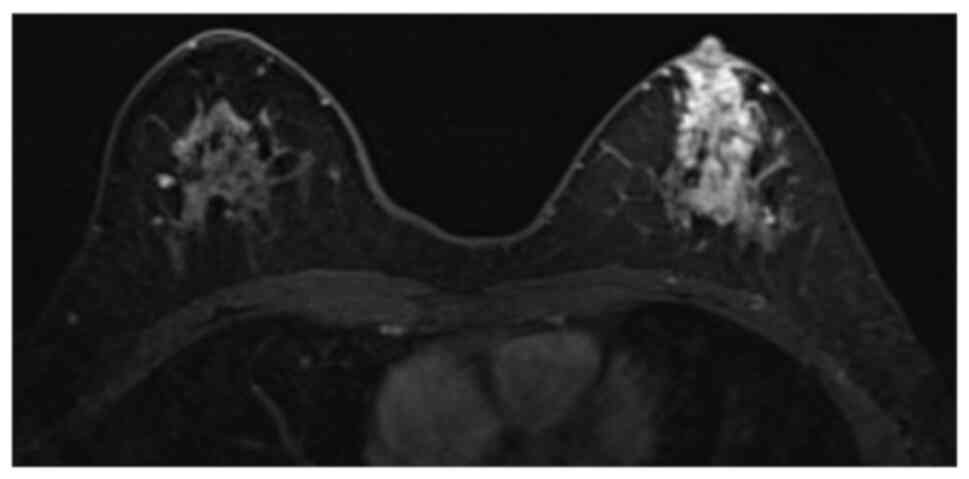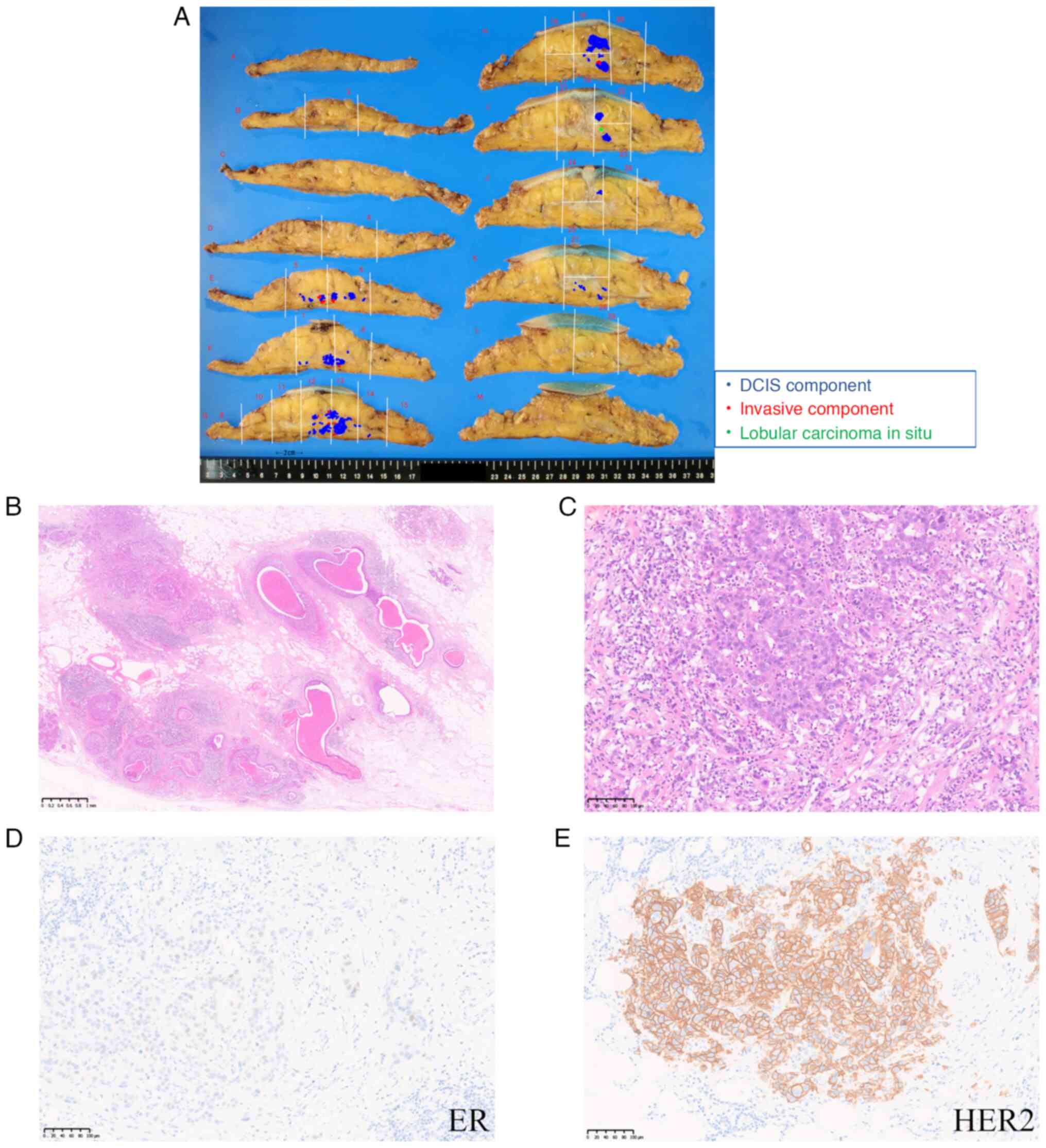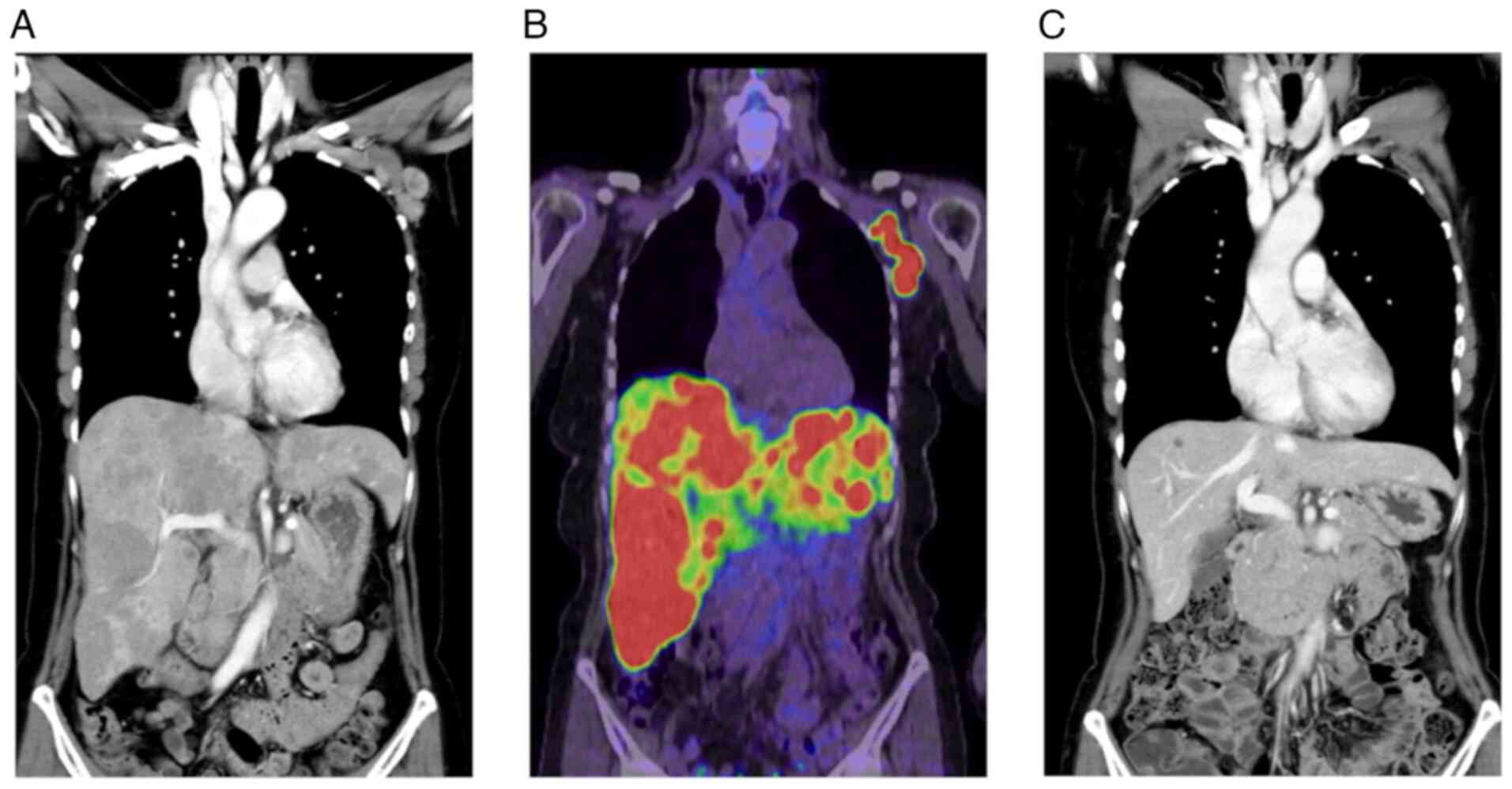|
1
|
Hudis CA: Trastuzumab-mechanism of action
and use in clinical practice. N Engl J Med. 357:39–51. 2007.
View Article : Google Scholar : PubMed/NCBI
|
|
2
|
National Comprehensive Cancer Network, .
http://www.nccn.org2019 December 10–2023
|
|
3
|
Tolaney SM, Guo H, Pernas S, Barry WT,
Dillon DA, Ritterhouse L, Schneider BP, Shen F, Fuhrman K, Baltay
M, et al: Seven-year follow-up analysis of adjuvant paclitaxel and
trastuzumab trial for node-negative, human epidermal growth factor
receptor 2-positive breast cancer. J Clin Oncol. 37:1868–1875.
2019. View Article : Google Scholar : PubMed/NCBI
|
|
4
|
Kubo M, Kawai M, Kumamaru H, Miyata H,
Tamura K, Yoshida M, Ogo E, Nagahashi M, Asaga S, Kojima Y, et al:
A population-based recurrence risk management study of patients
with pT1 node-negative HER2+ breast cancer: A national clinical
database study. Breast Cancer Res Treat. 178:647–656. 2019.
View Article : Google Scholar : PubMed/NCBI
|
|
5
|
Ma SJ, Oladeru OT and Singh AK:
Association of survival with chemoendocrine therapy in women with
small, hormone receptor-positive, ERBB2-positive, node-negative
breast cancer. JAMA Netw Open. 3:e2025072020. View Article : Google Scholar : PubMed/NCBI
|
|
6
|
Gonzalez-Angulo AM, Litton JK, Broglio KR,
Meric-Bernstam F, Rakkhit R, Cardoso F, Peintinger F, Hanrahan EO,
Sahin A, Guray M, et al: High risk of recurrence for patients with
breast cancer who have human epidermal growth factor receptor
2-positive, node-negative tumors 1 cm or smaller. J Clin Oncol.
27:5700–5706. 2009. View Article : Google Scholar : PubMed/NCBI
|
|
7
|
Brierley JD, Gospodarowicz MK and
Wittekind C: TNM classification of malignant tumours. John Wiley
& Sons; 2017
|
|
8
|
van Ramshorst MS, van der Heiden-van der
Loo M, Dackus GM, Linn SC and Sonke GS: The effect of
trastuzumab-based chemotherapy in small node-negative HER2-positive
breast cancer. Breast Cancer Res Treat. 158:361–371. 2016.
View Article : Google Scholar : PubMed/NCBI
|
|
9
|
Musolino A, Falcini F, Sikokis A, Boggiani
D, Rimanti A, Pellegrino B, Silini EM, Campanini N, Barbieri E,
Zamagni C, et al: Prognostic impact of interval breast cancer
detection in women with pT1a N0M0 breast cancer with HER2-positive
status: Results from a multicentre population-based cancer registry
study. Eur J Cancer. 88:10–20. 2018. View Article : Google Scholar : PubMed/NCBI
|
|
10
|
Musolino A, Boggiani D, Sikokis A, Rimanti
A, Pellegrino B, Vattiato R, Sgargi P, Falcini F, Caminiti C,
Michiara M and Leonardi F: Prognostic risk factors for treatment
decision in pT1a,b N0M0 HER2-positive breast cancers. Cancer Treat
Rev. 43:1–7. 2016. View Article : Google Scholar : PubMed/NCBI
|
|
11
|
Colleoni M, Rotmensz N, Peruzzotti G,
Maisonneuve P, Viale G, Renne G, Casadio C, Veronesi P, Intra M,
Torrisi R and Goldhirsch A: Minimal and small size invasive breast
cancer with no axillary lymph node involvement: The need for
tailored adjuvant therapies. Ann Oncol. 15:1633–1639. 2004.
View Article : Google Scholar : PubMed/NCBI
|
|
12
|
Inwald EC, Klinkhammer-Schalke M,
Hofstädter F, Zeman F, Koller M, Gerstenhauer M and Ortmann O:
Ki-67 is a prognostic parameter in breast cancer patients: Results
of a large population-based cohort of a cancer registry. Breast
Cancer Res Treat. 139:539–552. 2013. View Article : Google Scholar : PubMed/NCBI
|
|
13
|
Joerger M, Thürlimann B and Huober J:
Small HER2-positive, node-negative breast cancer: Who should
receive systemic adjuvant treatment? Ann Oncol. 22:17–23. 2011.
View Article : Google Scholar : PubMed/NCBI
|
|
14
|
Curigliano G, Viale G, Bagnardi V,
Fumagalli L, Locatelli M, Rotmensz N, Ghisini R, Colleoni M,
Munzone E, Veronesi P, et al: Clinical relevance of HER2
overexpression/amplification in patients with small tumor size and
node-negative breast cancer. J Clin Oncol. 27:5693–5699. 2009.
View Article : Google Scholar : PubMed/NCBI
|
|
15
|
Davey MG, Ryan ÉJ, Folan PJ, O'Halloran N,
Boland MR, Barry MK, Sweeney KJ, Malone CM, McLaughlin RJ, Kerin MJ
and Lowery AJ: The impact of progesterone receptor negativity on
oncological outcomes in oestrogen-receptor-positive breast cancer.
BJS Open. 5:zrab0402021. View Article : Google Scholar : PubMed/NCBI
|
|
16
|
Lagios MD, Margolin FR, Westdahl PR and
Rose MR: Mammographically detected duct carcinoma in situ.
Frequency of local recurrence following tylectomy and prognostic
effect of nuclear grade on local recurrence. Cancer. 63:618–624.
1989. View Article : Google Scholar : PubMed/NCBI
|
|
17
|
Petrelli F, Viale G, Cabiddu M and Barni
S: Prognostic value of different cut-off levels of Ki-67 in breast
cancer: A systematic review and meta-analysis of 64,196 patients.
Breast Cancer Res Treat. 153:477–491. 2015. View Article : Google Scholar : PubMed/NCBI
|
|
18
|
Tsuda H, Akiyama F, Kurosumi M, Sakamoto G
and Watanabe T: Establishment of histological criteria for
high-risk node-negative breast carcinoma for a multi-institutional
randomized clinical trial of adjuvant therapy. Japan national
surgical adjuvant study of breast cancer (NSAS-BC) pathology
section. Jpn J Clin Oncol. 28:486–491. 1998. View Article : Google Scholar : PubMed/NCBI
|
|
19
|
National Health Service, . Predict breast
cancer. University of Cambrigde; 2023, https://breast.predict.nhs.uk/December 10–2023
|
|
20
|
Grootes I, Wishart GC and Pharoah PDP: An
updated PREDICT breast cancer prognostic model including the
benefits and harms of radiotherapy. NPJ Breast Cancer. 10:62024.
View Article : Google Scholar : PubMed/NCBI
|
|
21
|
Waks AG, Ogayo ER, Paré L, Marín-Aguilera
M, Brasó-Maristany F, Galván P, Castillo O, Martínez-Sáez O,
Vivancos A, Villagrasa P, et al: Assessment of the HER2DX assay in
patients with ERBB2-positive breast cancer treated with neoadjuvant
paclitaxel, trastuzumab, and pertuzumab. JAMA Oncol. 9:835–840.
2023. View Article : Google Scholar : PubMed/NCBI
|
|
22
|
Salhia B, Trippel M, Pfaltz K, Cihoric N,
Grogg A, Lädrach C, Zlobec I and Tapia C: High tumor budding
stratifies breast cancer with metastatic properties. Breast Cancer
Res Treat. 150:363–371. 2015. View Article : Google Scholar : PubMed/NCBI
|
|
23
|
Dang C, Guo H, Najita J, Yardley D, Marcom
K, Albain K, Rugo H, Miller K, Ellis M, Shapira I, et al: Cardiac
outcomes of patients receiving adjuvant weekly paclitaxel and
trastuzumab for node-negative, ERBB2-positive breast cancer. JAMA
Oncol. 2:29–36. 2016. View Article : Google Scholar : PubMed/NCBI
|
|
24
|
Sengupta PP, Northfelt DW, Gentile F,
Zamorano JL and Khandheria BK: Trastuzumab-induced cardiotoxicity:
Heart failure at the crossroads. Mayo Clin Proc. 83:197–203. 2008.
View Article : Google Scholar : PubMed/NCBI
|
|
25
|
Guarneri V, Lenihan DJ, Valero V, Durand
JB, Broglio K, Hess KR, Michaud LB, Gonzalez-Angulo AM, Hortobagyi
GN and Esteva FJ: Long-term cardiac tolerability of trastuzumab in
metastatic breast cancer: The M.D. anderson cancer center
experience. J Clin Oncol. 24:4107–4115. 2006. View Article : Google Scholar : PubMed/NCBI
|
|
26
|
Moja L, Tagliabue L, Balduzzi S, Parmelli
E, Pistotti V, Guarneri V and D'Amico R: Trastuzumab containing
regimens for early breast cancer. Cochrane Database Syst Rev.
2012:CD0062432012.PubMed/NCBI
|
|
27
|
Sasaki R, Kurebayashi N, Eguchi H,
Horimoto Y, Shiga T, Miyazaki S, Kashiyama T, Akamatsu W and Saito
M: Involvement of kallikrein-PAR2-proinflammatory pathway in severe
trastuzumab-induced cardiotoxicity. Cancer Sci. 113:3449–3462.
2022. View Article : Google Scholar : PubMed/NCBI
|












